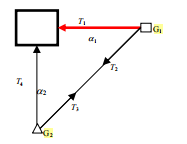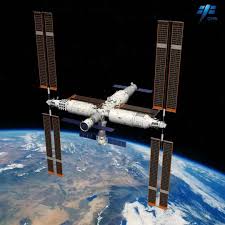For precision measurement of spacecraft equipment installation, a theodolite is usually used to measure the reference cubic mirror on the equipment (hereinafter referred to as the "reference mirror").
To establish a coordinate system through alignment, the fixed-position theodolite is used to aim at each other with multiple other theodolites to achieve datum transfer, and finally the installation attitude relationship between the two devices is obtained. In the complete docking state of the "Tiangong-1" large spacecraft, it is necessary to accurately measure the installation posture of the equipment when replacing equipment in the final assembly platforms at different heights and levels of 9 to 11 m. In order to ensure the accuracy of measurement, the platform must be used to separate humans and machines. This results in the theodolite being unable to aim at each other between different platforms during the measurement process to complete attitude measurement between devices. In order to solve this kind of problem, this paper conducts research on the measurement principle of gyro-theodolite, and cleverly uses the geodetic coordinate system as the intermediate transfer coordinate system to solve the problem of conventional theodolite testing being unable to establish the relationship between the reference mirror coordinate systems due to mutual sighting being blocked.
1.Application of gyro theodolite
1.1 Measuring principle of gyro-theodolite
The gyro-theodolite is an autonomous directional measuring instrument, which is an organic combination of a gyroscope and a theodolite. It uses the fixed axis and precession of the gyroscope to be sensitive to the Earth's rotation, thereby measuring the normal direction of the Earth's rotation, commonly known as the true north direction. It does not require any external information and can measure the true north direction within a range of 75° north and south, thereby obtaining the required orientation. The geodetic coordinate system can be defined by the true north direction and the geodetic horizontal plane. The relationship between the geodetic coordinate system and the theodolite absolute coordinate system is determined based on the reading of the code disk in the horizontal rotation plane of the theodolite in the true north direction.
1.2 Measurement algorithm of gyro-theodolite
The joint construction of the gyro-theodolite and theodolite is a new method. Its principle is to find the north through the gyro-theodolite and determine the true north datum. Use a theodolite to measure the normal pitch angle of the two mutually perpendicular horizontal reflection end surfaces of the measured reference mirror and the azimuth angle of the normal horizontal projection line. Using the relationship between spherical and solid trigonometric functions, the angles between the normals of each end surface of the reference mirror and the three coordinate axes of the geodetic coordinate system are calculated.
After measuring the attitude of the reference mirrors in the same coordinate system, the attitude between any two reference mirrors can be obtained through calculation, which is the attitude relationship between the reference mirrors.
The specific algorithm is as follows: use theodolite and gyro-theodolite to collimate and measure two arbitrarily placed reference mirrors, and perform mutual aiming between instruments after collimation. As shown in Figure 1, assume that the gyro-theodolite has observational quantities T1 (horizontal angle), V1 (elevation angle), a1 (azimuth angle) for the collimation of the cubic mirror, and the theodolite has the observational quantities T4, V2 and longitude for the collimation of the reference mirror. The transferred azimuth angle a2, the mutual aiming measurements of the gyro-theodolite and theodolite are T2 and T3

Figure 1 Reference mirror azimuth transfer diagram
The azimuth angle of the theodolite collimation after mutual aiming transfer can be obtained by the following formula
![]()
Based on the azimuth angle and vertical angle of the collimation line on each surface of the reference mirror, the direction cosine of each collimation direction is obtained:

1.3 Analysis of the accuracy error of the north position of the reference mirror measured by the gyro-theodolite
This mainly includes two items: one is the comprehensive error of the north-seeking orientation of the gyro; the other is the error of the theodolite, that is, the theodolite mutual aiming error, theodolite collimation error, and the gyro-theodolite collimation error. The attitude calibration process between cubic mirrors is equivalent to the alignment and mutual aiming measurement of two single reference mirrors. Each mutual aiming and collimation is regarded as the sighting of the theodolite, and the mutual aiming transfers the azimuth angle obtained by the reference mirror.
Summarize
According to the measurement principle of the gyro theodolite, the geodetic coordinate system is used as the intermediate transfer coordinate system, which solves the problem that the theodolite cannot establish the reference mirror coordinate system because the mutual sighting is blocked. The gyro-theodolite developed by ERICCO, such as: ER-GT-02, is a super High-precision gyro theodolite, orientation accuracy ≤3.6" (1σ); has strong pit interference capability, integrated body design, compact structure, and stable performance; most importantly, it can serve large spacecrafts and can be compared For accurate measurements, Ericco also has multiple gyroscopic theodolites.
If you would like to know more, please contact us.


.jpg)

No comments:
Post a Comment